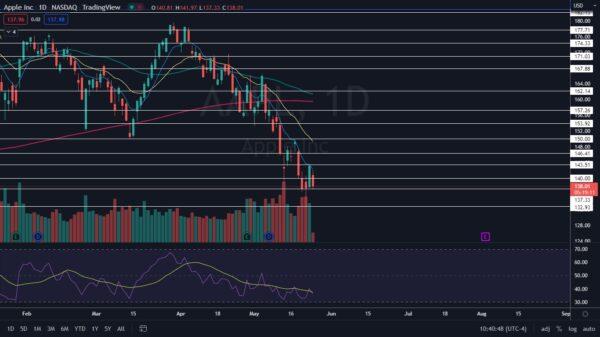Apple Inc. opened lower on Tuesday after spiking up 3.86 percent on Monday in a relief bounce that led the S&P 500 to 1.39 percent higher.
Stocks in the broader technology sector are being dragged down on Tuesday by Snap Inc. after a Form 8-K filing was released on Monday showing Snap forecasts its second-quarter revenues to come in under the lowest range of its guidance issued on April 21.
At press time, Meta Platforms, Inc. and Alphabet, Inc. were trading down over 9 percent and 7 percent, respectively, in sympathy with Snap. Investors have grown concerned Snap’s outlook for the second quarter is indicative of the tech sector in general as soaring inflation and rising interest rates appear to be slowing the economy.
From a technical standpoint, Apple is trading lower in continuation of a downtrend that the stock has been stuck in since March 30 and for now, any bounces to the upside are likely to be short-lived.
A downtrend occurs when a stock consistently makes a series of lower lows and lower highs on the chart.
The lower lows indicate the bears are in control while the intermittent lower highs indicate consolidation periods.
Traders can use moving averages to help identify a downtrend with descending lower timeframe moving averages (such as the eight-day or 21-day exponential moving averages) indicating the stock is in a steep shorter-term downtrend and descending longer-term moving averages (such as the 200-day simple moving average) indicating a long-term downtrend.
A stock often signals when the lower low is in by printing a reversal candlestick such as a doji, bullish engulfing, or hammer candlestick. Likewise, the lower high could be signaled when a doji, gravestone, or dragonfly candlestick is printed. Moreover, the lower lows and lower highs often take place at resistance and support levels.
- Bearish traders who are already holding a position in a stock can feel confident the downtrend will continue unless the stock makes a higher high. Traders looking to take a position in a stock trading in a downtrend can usually find the safest entry on the lower high.
- Bullish traders can enter the trade on the lower low and exit on the lower high. These traders can also enter when the downtrend breaks and the stock makes a higher high indicating a reversal into an uptrend may be in the cards.
The Apple Chart
Apple’s most recent lower low in its downtrend was printed on May 20 at the $132.61 mark and the most recent lower high was formed at the $143.26 mark on Monday. On Tuesday, Apple momentarily dropped below Monday’s low-of-day, but didn’t immediately receive follow-through.- The lack of momentum when Apple fell under Monday’s low-of-day has set the stock into an inside bar pattern on the daily chart. If the stock continues to trade within Monday’s range throughout Tuesday, Apple may form a tightening pattern on lower timeframes, such as a triangle on the four-hour chart.
- If that happens, traders can watch for a break up or down from the sideways trading pattern on higher-than-average volume to gauge future direction. The inside bar learns slightly bearish because Tuesday’s price action is taking place at the lower end of Monday’s mother bar.
- Bullish traders will want to see Apple regain the eight-day exponential moving average (EMA) as support to feel more confident going forward. The eight-day EMA has proven to be heavy resistance, guiding the stock lower since May 6. Bearish traders will want to see Apple break down from Monday’s price range, which could push the stock down to test the May 20 low-of-day as support.
- Bullish traders should note that entering a position is counter to the current trend and upside potential is likely to be short-lived. Bearish traders should watch for a sign of a possible reversal to protect their position, such as a reversal candlestick or a double bottom pattern to form.







Friends Read Free